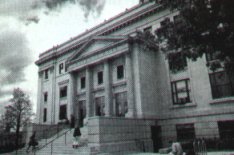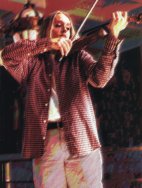
Vol. 9 No. 1 THE MAGAZINE OF THE UNIVERSITY OF UTAH Summer 1999
Continuum Home Page
- University of Utah Home Page - Alumni
Association Home Page
Questions, Comments - Table of Contents

IN TUNE WITH THE TIMES
The saga of Gardner Hall, the music building left to ruin and later reclaimed to glory, embodies tragedy and triumph of operatic proportion.
Like a diva who outlasted her romantic rivals, Gardner Hall paid her dues before earning a $15.3 million state commitment for improvements. For years, the needed renovation and expansion of the 78-year-old building were placed on hold until financing was secured.
Finally, this fall, students and music lovers will be able to enjoy improved facilities within a historically preserved structure. The new Gardner Hall will host student performances, provide opportunities for community classes and recitals, and feature a modern pipe organ. The building's thoughtful planning blends historical accuracy with clean modern lines, restoring the building to elegance but supplementing it with temperature and acoustical control, as well as technological amenities.
 |
Guitarist Gawain Mathews, a jazz performance major, at his senior recital. |
Plans had initially called for remodeling the building's interior to include a concert hall, but shoehorning a proper recital space into the old ballroom proved unfeasible. Campus Design and Construction Director John Huish BFA'63 BArch'65 suggested building a "little jewel of a concert hall" behind Gardner Hall. That "little jewel" grew to become a state-of-the-art facility that will house the third largest pipe organ in the state. Now called Concert Hall, the new building is contemporary in design, with exquisite woodwork. It is scheduled for completion in 2000.
The outfitting of Gardner Hall "is a response to functional requirements," explains Rick Frerichs, architect at FFKR, the firm that designed the renovation and expansion of Gardner Hall and designed Abravanel Hall. "Gardner Hall and the Concert Hall are acoustically isolated from each other, with ceilings designed to disperse sound to the greatest extent possible." The integrity of the ballroom, revered by former students, has been restored. A grand staircase leads to it, and above, on the fourth level, is a recital room. Most of the other spaces are utilitarian in design. Gardner Hall is connected to the Concert Hall by corridors that run on either side of the old ballroom and act as bridges. A glass atrium connects the two buildings.
 |
Choosing music as a profession is something you
do because your soul won't let you choose anything else."
– Violin major Karen Maloy |
The music department, whose students have been assigned makeshift studios and practice rooms across campus, hopes to move back to Gardner Hall by July. However, the Concert Hall has a later completion date due to the addition of a limestone exterior late in the building's construction. The pipe organ will be installed by February 2000. It will serve both as a concert instrument for students and guest performers, and to accompany choruses.
While construction workers toil, Presidents Circle has been filled with opposing sounds. From the east rise piano chords accompanying clear soprano trills emanating from what was the old communication building. From the west, construction trucks beep their warnings into the afternoon sky. Out of windows in the Cowles Building escape the resonant sounds of a tuba, lyric flute notes, and the steady beat of drums. The breadth of music department specialties is mirrored by the range of sounds. A student can immerse herself in the history of music, jazz, chorus, or music education. For students who aspire to perform, the options include voice, piano, or instrumental (brass, woodwind, strings, and percussion) studies. Gardner Hall -Channel 7, and later, with the ballet department. "It couldn't have been a worse match," sighs Edgar Thompson PhD'73, chair of the music department. "KUED needed quiet, and the music department needed noise, and the ballet needed space." The friction initiated several plans for renovating the building. Thompson can remember at least four potential plans, one that suggested blasting out the ballroom and another, adding an annex. In addition to leaks and creaks, Gardner Hall was quite uncomfortable: the antiquated heating system didn't work in the winter, and because it had no air conditioning, concerts were off-limits between May and October. When KUED moved to the Eccles Broadcast Center, discussion of renovation began in earnest.
Emeritus Professor of Music Ardean Watts MA'60, also retired associate conductor and pianist for the Utah Symphony, says that the renovation was crucial in order for performers to hear themselves. And students weren't the only ones who suffered, Watts explains. "The audience got a mixture of echoes and strange sounds, as well as a terrific amount of interference from street noise and the heating systems in the building during performances. It never did offer what the department needed. For instance, no spaces were acoustically isolated from one another, so the sounds from practice rooms could be heard in the middle of concerts." Without a place to perform, musicians have been disadvantaged, he observes. "Music is, after all, a kind of ceremony with audience, and if it isn't shared with an audience, it's a questionable enterprise in the first place. For a music department to have some status without having concert venues of its own is as unthinkable as a chemistry department without a lab," says Watts, who taught at the U for 33 years.
According to Watts, engineers from Vanguard Records were the most resourceful in muffling outside noise. To simulate satisfactory room ambience when the Symphony made recordings at Gardner Hall, they set up speakers in the men's restrooms and then re-recorded the sound as it bounced around the walls. Kingsbury Hall, Watts notes, wasn't any better as a performing venue. It was designed as a theater and lecture hall, and never conceived of for music. Watts relays, "Although it is a beautiful place and certainly worthy of preservation, I have conducted hundreds of performances in Kingsbury Hall – about 20 operas, and symphony orchestras, musicals for Pioneer Theatre – and none of them were successful. The only time that venue was really successful for a concert was when we built wooden platforms out from the center of the stage and sat out where the audience was. Otherwise much of the sound goes up in the fly area. It was always really difficult to achieve any kind of projection and blend of the sound."
Community members have been forthcoming with gifts to support the improvements. The Eccles Foundation contributed an initial $5 million, then added $850,000 more for the pipe organ. Megahertz Corporation co-founder David Spafford, a former music student, donated $250,000. In doing so, these benefactors help the University in the battle to attract and retain students.
Composer Morris Rosenzweig, an associate professor of music, says, "Institutions are looking at themselves seriously and asking what they can do to improve. The Concert Hall is a facility we need badly." Rosenzweig, the recipient of a Guggenheim Foundation fellowship who has earned several commissions for his work, including one by Harvard University's Fromm Foundation, adds, "We have no small acoustic hall in Salt Lake, period. The only classical one is Abravanel Hall. People will be lining up to use the Concert Hall."
The U's music department does more than teach college students. The pianist duo of Susan Duehlmeier BFA'70 MFA'73 and Bonnie Gritton BFA'70 is earning recognition for teaching and outreach. Duehlmeier won the Presidential Teaching Award in 1994. Gritton recently won the Bennion Center Teaching Award for starting an outreach program in local at-risk schools. For them, performing and teaching go hand in hand. Most weeks include 60 hours of work, balancing teaching schedules with performances and practice. Asked about her motivation, Duehlmeier cites the results of helping students learn music. "We have fabulous stars that have graduated from the University of Utah. One is singing with the Metropolitan Opera, another is a Steinway artist. Most of our students have done amazing things after they left us." Gritton adds that studying music requires communication skills, instinct, and self-motivation.
Public outreach is also on the mind of Janet Mann, director of the U's "preparatory division." She shares her enthusiasm for music with local children. The division's courses, which serve 475 children from the community, begin with the Kinder Music Program. Children from infants to age five enjoy listening to music, singing, and learning to internalize rhythm. From age six to eight, participating children come to campus for weekly piano group classes as well as private lessons. Students in the third through twelfth grades may enroll in monthly classes, performances, and private lessons. The program is both rigorous and dearly loved. Mann says, "These are normal children exposed to music, not just the talented students. It is rewarding to witness their personal growth and help formulate their self-images. I'm not just teaching piano, I'm giving them something they will use for the rest of their lives. It is highly unusual to have someone only perform – 98 percent end up teaching. They use their performance skills to help others learn," she maintains.
Research has identified that learning music may help students learn math skills. The popularity of the children's programs has grown steadily, which may give the U a leg up in attracting students to enroll after high school. From his vantage point as a private teacher in the preparatory division, Saeow Quah, a graduate student in piano performance, says that music is not only for enjoyment but helps learners focus. He says, "Some of my students tell me they are borderline ADD [affected by Attention Deficit Disorder]. I tell them I don't believe it, and two years later they are better." Quah is from Malaysia, and says that he selected Utah for his studies because of the strength of its piano pedagogy program. "Many schools don't have a teaching methods program," Quah explains. "At Utah, we spend three to four years learning theory, history, curriculum planning, and performance skills. I feel very privileged to have studied here."
Students choose to study music for a variety of reasons. Jason Dam is a senior in piano performance who had not considered majoring in music until Mann, his private teacher, convinced him that he should. He has no regrets about his decision. "We have yearly department-wide recitals as well as quarterly convocations," he says. "They take a lot of preparation. On a good week I practice three hours or more every day." Dam says the practice is worthwhile because of the enjoyment he derives from performing.
Violin major Karen Maloy, a senior at Utah, agrees. "Choosing music as a profession is something you do because your soul won't let you choose anything else," she declares. Maloy – who performs with the Honors Quartet, is the concertmaster of the Philharmonic Orchestra, and presides over the supervisory committee in Utah's Music Department – believes the U was a natural place to study her chosen profession. She has been invited to study with Pincas Zuckerman in New York and has performed all over the country.
Maloy's dedication to her profession and professors goes beyond diligent studying. She has helped to organize "1,000 for 1,000," a fund-raising event for scholarships. There are 1,000 seats at Gardner Hall, and the student committee hopes to sell endowments for each one for $1,000. "It would be terrible to have this Concert Hall and no students to fill it," Maloy says. Funding music education is a perennial problem at the U. In contrast, at the Curtis Institute of Music in Philadelphia, qualified applicants are exempt from tuition. "It turns out phenomenal students because they've had the focus and time to practice. We have such incredible opportunities in our community but lack the funding necessary for scholarships like these," according to Maloy. "I have studied with the great violin teachers; the best there are have been right here all along." The University is one of a very few institutions of higher education that grants doctoral degrees in music.
To show off its new facilities, the University will host the research seminar for the International Society of Music Education in 2000. "We have several outreach programs such as the one Gritton is involved with, where directors bring their organizations to the University to perform, and then the groups are adjudicated by the faculty," notes Edward Asmus, director of graduate programs and music education.
Gardner Hall's restoration exemplifies the University's role in developing and sustaining music appreciation, as well as providing music education at both the collegiate and community levels. Participation in high school music programs might indicate demand for the programs that Gardner Hall will feature. Each spring state music festival competitions sponsored by the Utah Music Educators' Association draw more than 27,000 high school students.
"Art is not for the elite – it is for the masses," proclaims Robert Breault, who teaches voice at Utah and produced the opera Cosi' Fan Tutte, the first student opera in over 20 years at the U. Says Breault, "I love performing in Utah because you see such a cross-section of society in the audience. When I perform in Carnegie Hall, it's blue hair and bald heads. Here, there are lots of young children." Gardner Hall and the Concert Hall will provide children – who one day may look to the U for music education – a place of their own to shine.
– Natalie Taylor BFA'89 is a freelance writer and recipient of The Utah Arts Council Original Writing Competition second-place award in creative nonfiction for her book, Rain.
Continuum Home Page - University of Utah Home Page - Alumni Association Home Page
Questions, Comments - Table of Contents
Copyright 1999 by The University of Utah Alumni Association